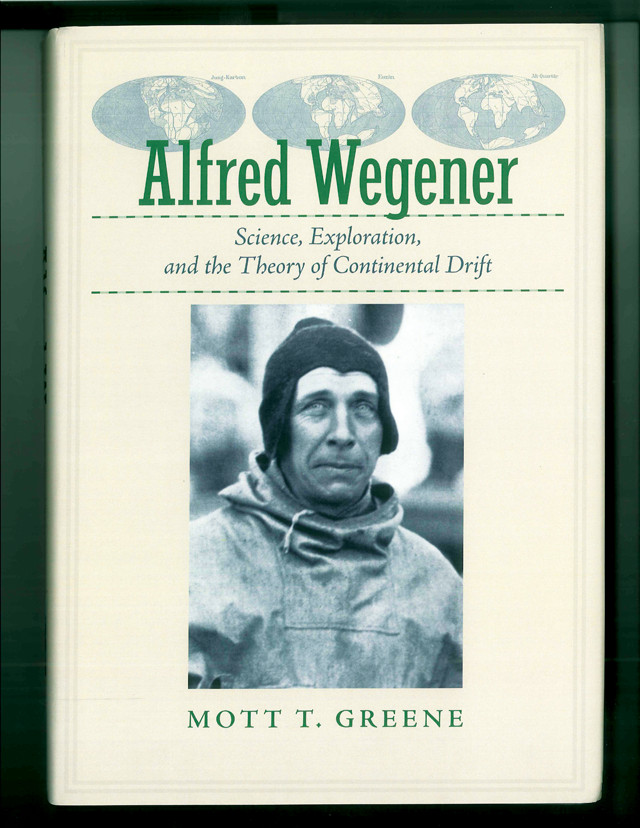
by Rasoul Sorkhabi Tuesday, September 20, 2016

"Alfred Wegener: Science, Exploration and the Theory of Continental Drift," by Mott T. Greene, Johns Hopkins University Press, 2015, ISBN 9781421417127.
Today, Alfred Wegener’s name appears in almost every geology textbook. He is celebrated as the father of the continental drift hypothesis, the forerunner of plate tectonics. This recognition is rather recent — since about the early 1970s, when plate tectonics became a unifying theory to explain the origins of continents, oceans, mountains, volcanism and many other geologic processes. During his life, Wegener’s hypothesis was rejected by many geologists, more so in North America than in Europe. The dramatic change of his status from heretic to hero thus makes Wegener’s story even more fascinating, not only to earth scientists but to general readers as well.
A number of books have tackled the history of the continental drift and plate tectonic theories. However, there are few detailed, scholarly works on Wegener himself. The first material on Wegener I remember reading was Anthony Hallam’s February 1975 article in Scientific American. Then came Martin Schwarzbach’s “Alfred Wegener: The Father of Continental Drift” in 1986 (originally published in German in 1980). Mott Greene’s new and groundbreaking book on Wegener, “Alfred Wegener: Science, Exploration and the Theory of Continental Drift,” adds much to the literature and literacy about one of the giants of earth science.
Greene follows Wegener’s life, career and scientific contributions in chronological order. Born in Berlin in 1880 as the youngest child of Richard, a language teacher and preacher, and educated at the universities of Heidelberg, Innsbruck and Berlin, Wegener earned a doctorate in astronomy in 1905, but worked as a meteorologist, Arctic explorer, climatologist, geophysicist and university professor. In 1913, he married Else Köppen, daughter of the famous climatologist Wladimir Köppen, with whom Wegener wrote a 1924 book, “The Climates of the Geological Past.”
Wegener participated in four Greenland expeditions in 1906, 1912, 1920 and 1930. The last, which he led, sought to calculate the rate of ice-cap drift, but it proved ill-fated: In November 1930 (the month he turned 50), Wegener died of a heart attack brought on by overexertion while crossing the ice. Greene devotes the last chapter of his book to Wegener’s last Greenland expedition; for more details, read Roger McCoy’s 2006 book, “Ending in Ice: The Revolutionary Idea and Tragic Expedition of Alfred Wegener.”
Wegener published his hypothesis of what he originally called “Kontinentalverschiebung” (“Continental Displacements,” later translated into English as “continental drift”) in German journals, which became the basis of his famous book in 1915, “The Origin of Continents and Oceans.” Over the years, he continuously gathered evidence for continental drift and expanded his book — from 94 pages in the 1915 first edition to 231 pages in the 1929 fourth edition. The fourth and last edition was translated from German into English by John Biram in 1966, amid the plate tectonics revolution.
As Greene notes, by age 35, Wegener was an accomplished scientist: He had published several papers and a textbook and had set the world record — 54 hours — for staying aloft in a free balloon. But why did it take nearly half a century for the geological community to embrace the idea of continental drift? Was it because scientific evidence for the theory was insufficient prior to the 1960s, or because Wegener could not elucidate a plausible mechanism for how the drift occurred? Was it because geologists resented an outsider (a meteorologist) encroaching on their science, or because Wegener was not politician enough to promote his science? Perhaps all of these are true to some degree. (Naomi Oreskes’ 1999 book, “The Rejection of Continental Drift: Theory and Method in American Earth Science,” tackles these questions in greater detail.)
Greene, a geoscientist who specializes in earth science history, spent more than 20 years researching and writing the book. He studied the previous literature on Wegener — including the German biographies by his wife Else and by the world expert on Wegener documents, Ulrich Wutzke — and visited the various places Wegener lived and worked, and examined the archives of Wegener documents at museums in Munich, Brandenburg and Neuruppin, in Germany, and the Dansk Polarcenter in Copenhagen. The result is a monumental scholarly work and the definitive book on the life and contributions of one of the brilliant stars in the history of earth science.
© 2008-2021. All rights reserved. Any copying, redistribution or retransmission of any of the contents of this service without the expressed written permission of the American Geosciences Institute is expressly prohibited. Click here for all copyright requests.